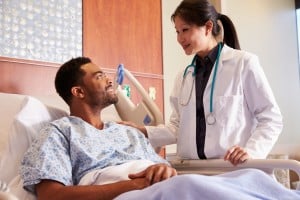The idea of an emergency appendectomy is scary, but it’s actually a very common surgery that about 1 in 20 Americans will have at some point in their life.
The classic symptom of acute appendicitis is increasingly severe pain in the lower right stomach. Patients should seek medical care immediately.
Fortunately, an appendectomy is typically a minimally invasive, routine surgery, and many patients go home the same day or next day feeling much better.
An appendectomy is a scary prospect for anyone, but it’s actually a very common emergency surgery, with over 1 in 20 Americans needing the procedure at some point in their life.
With that in mind, Regional One Health general surgeon Nabajit Choudhury, MBBS, MS, is offering peace of mind by giving patients an idea of what to expect.
“If it’s an uncomplicated appendectomy, many patients can go home the next day or even the same day, and a couple weeks later they’re back to their normal life,” Dr. Choudhury said.
“Once they recover from the procedure, they feel great – the appendix that had been infected or inflamed is out of their body, so they’re no longer in pain.”
The classic symptom of acute appendicitis is pain in the lower right abdomen.
Sometimes pain will start around the belly button and move toward the lower right side. The pain becomes increasingly severe, and patients may experience nausea, vomiting and fever.

Dr. Nabajit Choudhury said most patients immediately feel better after an appendectomy. “They’re a totally different person. They forget about the pain from the appendicitis, and the only discomfort is from the incisions, which we can help them manage.”
If you have these symptoms and suspect appendicitis, seek care immediately – early intervention prevents the condition from becoming more complex and difficult to treat.
“Almost all of these patients come through the emergency room, because it is an acute disease,” Dr. Choudhury said. “Once we diagnose acute appendicitis, the patient is taken to the operating room for surgery under general anesthesia.”
An appendectomy can take as little as 20 minutes, although in more complicated cases, patients are in surgery for over an hour. Dr. Choudhury is typically able to operate laparoscopically with three tiny incisions – one near the belly button and two on the left side of the abdomen.
Usually, removal of the appendix is all it takes to fix the problem. “Afterwards, most people feel great – they’re a totally different person,” Dr. Choudhury said. “They forget about the pain from the appendicitis, and the only discomfort is from the incisions, which we can help them manage.”
There are some instances where an appendectomy is more complex.
If the appendix bursts before removal, infection spreads throughout the abdomen. In some cases, an abscess, or pocket of fluid, forms. These patients will need IV antibiotics and usually stay in the hospital for two or three days for observation.
Sometimes patients will also need a drain in the area of the surgery. This can be removed before they leave the hospital, or later in the surgeon’s office.
Fortunately, most patients rebound quickly after an emergency appendectomy.
With the pain from their inflamed appendicitis gone, it’s simply a matter of recovering from the incisions and the procedure itself, Dr. Choudhury said – a person does not need their appendix to survive, so having it removed does not have negative consequences.

Most patients go home the same day or next day after having an appendectomy. After about two weeks, they can typically be cleared to resume their normal activities.
Patients are advised to keep their incisions clean to avoid infection and to take pain medication as recommended by their doctor. Most people can eat and be up and about the day after surgery but should avoid strenuous activity.
Dr. Choudhury sees patients for a follow-up about two weeks after their surgery and often can clear them to return to normal activities.
Bottom line, while appendicitis is a medical emergency that requires prompt treatment, patients can rest easy that it is a routine procedure with excellent outcomes and a quick recovery.
“A lot of patients have anxiety about surgery, so I always tell them what they can expect from the procedure and the recovery,” Dr. Choudhury said. “I understand this is a big deal for a patient and their family, so I look for ways to put them at ease.”
Along with emergency procedures, Dr. Choudhury performs elective outpatient surgeries to treat hernias, gallstones, stomach ulcers, diverticulitis, intestinal blockage and more.
He sees patients at our East Campus, 6555 Quince Road, and Outpatient Center, 880 Madison Avenue.